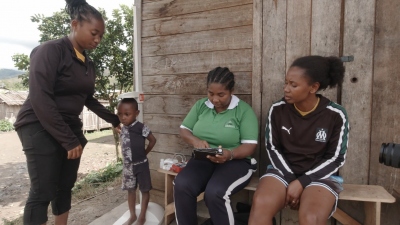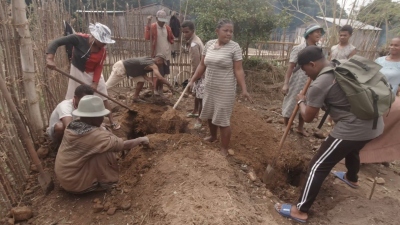Duke Students Research Lemurs, Agriculture and Public Health Alongside Peers in Madagascar
September 13, 2022
By James Herrera, Program Coordinator, Duke Lemur Center – SAVA Conservation


We can hardly believe that over 10 weeks have passed since our multi-institutional student team from the United States arrived in early June. Ever since, the team accomplished more than they ever imagined when they left Duke, Macalester and the University of California, Davis. Partnering with their peers at two universities in Madagascar, they lived in remote, rural communities bordering some of the last rainforests remaining in the SAVA region. (SAVA stands for the Sambava-Andapa-Vohemar-Antalaha region of northeast Madagascar.)
Since our last update, the ecology and social science subteams sprinted to the finish line as they wrapped up their summer field work. In the forest, Ph.D. student Camille DeSisto’s team collected fecal samples from lemurs that were loaded with seeds and planted those seeds in their tree nursery. In total, the team encountered four day-active lemur species almost 40 times and collected 119 fecal samples, with about 60% containing seeds. They also collected data on tree diversity in different habitats, with as few as 10 species found in regenerating forests and up to 50 species in the primary rainforest. Camille also piloted a unique social-ecological survey to glean information from local experts on interactions between lemurs and trees, as well as how people use those same trees. The survey reveals the importance of the over 200 tree species in the region for lemurs as well as the daily lives of communities living near the forest.

Camille mentors a graduate student, Jeremia Andrianajaona, from the University of Antananarivo in the capital. Jeremia is studying the elusive nocturnal lemurs, especially the hairy-eared dwarf lemur and mouse lemurs. Setting 60 live traps per night, Jeremia and his team have captured 14 mouse lemurs and four hairy-eared dwarf lemurs, measuring their weight and size and releasing them back into the wild. Jeremia will use this pilot study to develop his Ph.D. project, supported by the DLC-SAVA Conservation Initiative.
Ph.D. student Edgar Rabevao and his team collected data on lemur diversity in different habitat types. They conducted almost 200 kilometers of transect surveys and encountered lemurs 180 times, finding an amazing abundance and diversity of the nocturnal species. Edgar’s goal is to understand more about the distribution and abundance of the critically endangered silky sifaka, identifying three distinct social groups in the survey area. With his team of SAVA Regional University Center (CURSA) colleagues and local forest managers, Edgar will survey multiple sites throughout the COMATSA protected area to quantify how many silky sifakas occur in the protected area and the threats to their viability.

In the rural community, master of public policy student Maggie Poulos conducted over 60 interviews with farmers, cooperatives, vanilla buyers, national and international vanilla companies, and USAID. She is learning that to combat the challenges associated with vanilla farming, including theft and volatile prices, farmers want to create village-based savings and loans associations to secure their money, and to diversify income-generating activities through market vegetable farming, domestic animal husbandry, and creating sewing and soap-making cooperatives. We will partner with diverse actors to implement these strategies with the communities around the COMATSA protected area.
 Master of international development policy student Bethany Old also conducted 16 interviews and focus groups on nutritional health with diverse stakeholders, including mothers in the rural community, doctors and health agents, the national and regional Ministry of Health, USAID, the World Bank and others. She found significant obstacles to attaining essential nutritional health for women and children, which leads to poor health and development. Women often lack basic information about what constitutes a healthy diet and have difficulty accessing the diverse fruits, vegetables and meat that provide the macro- and micro-nutrients they need. With this information, Bethany is developing a policy brief to share with stakeholders at multiple levels to provide guidance on how nutrition interventions can better serve rural communities.
Master of international development policy student Bethany Old also conducted 16 interviews and focus groups on nutritional health with diverse stakeholders, including mothers in the rural community, doctors and health agents, the national and regional Ministry of Health, USAID, the World Bank and others. She found significant obstacles to attaining essential nutritional health for women and children, which leads to poor health and development. Women often lack basic information about what constitutes a healthy diet and have difficulty accessing the diverse fruits, vegetables and meat that provide the macro- and micro-nutrients they need. With this information, Bethany is developing a policy brief to share with stakeholders at multiple levels to provide guidance on how nutrition interventions can better serve rural communities.

Macalester undergraduate Jane followed up on her landscape and resource mapping project by interviewing farmers about their crop diversity, crop rotation, and challenges they face. The overall results show farmers focus on only a few staple crops, especially rice and vanilla, while fruit and vegetable crops are less common. These results link with the nutritional and socioeconomic interviews conducted by Maggie, Bethany and Malagasy partners Ardhilles and Nestorine to clarify the needs of the communities to attain food and nutritional security.
Ardhilles and Nestorine, Ph.D. students based at the university in SAVA, each conducted over 125 surveys on socioeconomics, land use, agriculture, food and nutritional security, and nutritional health. The results demonstrate that crop diversity and productivity as well as income are too low to meet the needs of households, with 87% of respondents experiencing moderate to severe food insecurity. In addition, 4% of mothers and 22% of children under 5 years old were anemic. The research also showed how people use local resources, such as diverse trees, for construction, food and medicine.

To overcome these challenges, the DLC-SAVA Conservation program partners with CURSA to deliver value-added training in diversified agroecology, teaching farmers how to amend low quality soils and plant diverse, nutrient-dense crops that can provide food for the household as well as supplemental income from selling surplus crops. During the field work, six workshops were held with over 60 participants to create small home vegetable gardens, create compost, and teach about how these methods can be extended to other crops on larger scales. We will follow up with these participants to provide training in farming chicken and fish, which are important domestic animals for local consumption and sale.

With her own distinct subteam, University of California, Davis Ph.D. student Marie conducted social-ecological research at the Ambanitaza mountain near Antalaha. She used participatory research methods with three communities to understand how farmers use the landscape surrounding the sacred mountain to meet their daily needs. She also conducted botanical inventories of the abundance and diversity of trees, which are important for regulatory and provisional ecosystem services. She learned from communities about the history of land use, including how external forces led to large-scale deforestation on the mountain.

With international buyers exploiting timber from the mountain, many people moved to the site seeking wage labor. Cyclones and fires were a continual threat to the remaining forest over the last two decades. Forest loss has resulted in deteriorating provisional services, such as drying rivers and streams upon which the villages depend for irrigation, drinking, and cooking. Marie and her colleagues from CURSA, Dr. Marie Rolande, Anicet and Rauchilla, will use their results to help the community create a locally managed protected area that will restore the landscape of the mountain with native trees as well as diverse agroforestry along the slopes.
Though the departure of the U.S.-based students was full of tearful goodbyes, all of us on the team know that this is just the beginning of a long-term collaborative project. Camille plans to return for more field ecology research, and Edgar and his team will continue surveying more sites throughout the coming months. The Malagasy social sciences team is conducting interviews and agroecology workshops with eight communities around the SAVA, as well as follow-ups at COMATSA to continue training and consulting farmers in improved agriculture. With the start of the academic year, the U.S. and Malagasy teams will collaborate virtually by participating in a Bass Connections team, meeting weekly to update on progress in research and development projects. We look forward to the months to come!
James Herrera is a team leader of the Bass Connections project Biocultural Sustainability in Madagascar. Between June and August 2022, team members conducted research and conservation in rural communities around the northeast. Students from Duke, Macalester College and the University of California, Davis worked alongside their peers from universities in Madagascar and dozens of local partners from forest-bordering communities. Together, they conducted research, led sustainability workshops and taught about the value of the environment for nature and people.
Learn More
- View the three-part series of reflections from the Biocultural Sustainability in Madagascar project team, which details the team’s first few weeks in Madagascar, the work of their forest ecology and social science subteams, and their study of local livelihoods in the region.
- Submit a proposal for a 2023-2024 Bass Connections project by November 7.
- Explore the Energy & Environment theme to find more project teams that work in conservation and biodiversity.
